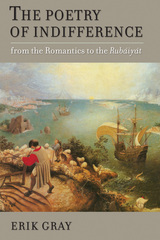3 books by Gray, Erik

The Born in the Spring
A Collection of Spring Wildflowers
June Carver Roberts
Ohio University Press, 2024
A must for flower and art lovers, Born in the Spring is a unique collection of line drawings and magnificent watercolors of spring wildflowers. All of the drawings and paintings were done from living plants, in minute detail, with complete botanical accuracy. There are over 90 illustrations, 46 of which are in full color. The text accompanying each plate enables the reader to easily locate the flower in its natural setting. The text also includes the origins of the common and botanical names, and bits of history and lore connected with the flowers. Some are hardy aliens that have come from all over the world, while others are fragile natives described by the earliest settlers; some are now becoming rare.
[more]

Love among the Poets
The Victorian Poetics of Intimacy
Pearl Chaozon Bauer; Erik Gray
Ohio University Press, 2024
British literature of the Victorian period has always been celebrated for the quality, innovativeness, and sheer profusion of its love poetry. Every major Victorian poet produced notable poems about love. This includes not only canonical figures, such as Alfred Lord Tennyson, Robert and Elizabeth Barrett Browning, and Christina Rossetti, but also lesser-known poets whose works have only recently become widely recognized and studied, such as Augusta Webster and the many often anonymous working-class poets whose verses filled the pages of popular periodicals. Modern critics have claimed, convincingly, that love poetry is not just one strain of Victorian poetry among many; it is arguably its representative, even definitive, mode. This collection of essays reconsiders the Victorian poetry of love and, just as importantly, of intimacy—a more inclusive term that comprehends not only romance but love for family, for God, for animals, and for language itself. Together the essays seek to define a poetics of intimacy that arose during the Victorian period and that continues today, a set of poetic structures and strategies by which poets can represent and encode feelings of love. There exist many studies of intimate relations (especially marriage) in Victorian novels. But although poetry rivals the novel in the depth and diversity of its treatment of love, marriage, and intimacy, that aspect of Victorian verse has remained underexamined. Love among the Poets offers an expansive critical overview. With its slate of distinguished contributors, including scholars from the US, Canada, Britain, and Australia, the volume is a wide-ranging account of this vital era of poetry and of its importance for the way we continue to write, love, and live today.
[more]

The Poetry of Indifference
From the Romantics to the Rubaiyat
Erik Irving Gray
University of Massachusetts Press, 2005
Indifference is a common, even indispensable element of human experience. But it is rare in poetry, which is traditionally defined by its direct opposition to indifference—by its heightened emotion, consciousness, and effort. This definition applies especially to English poets of the nineteenth century, heirs to an age that predicated aesthetics on moral sentiment or feeling. Yet it was in this period, Erik Gray argues, that a concentrated strain
of poetic indifference began to emerge.
The Poetry of Indifference analyzes nineteenth-century works by Wordsworth, Keats, Byron, Tennyson, Robert Browning, and Edward FitzGerald, among others—works that do not merely declare themselves to be indifferent but formally enact the indifference they describe. Each poem consciously disregards some aspect of poetry that is usually considered to be crucial or definitive, even at the risk of seeming "indifferent" in the sense of "mediocre." Such gestures discourage critical attention, since the poetry of indifference refuses to make claims for itself.
This is particularly true of FitzGerald's Rubáiyát, one of the most popular poems of the nineteenth century, but one that recent critics have almost entirely ignored. In concentrating on this underexplored mode of poetry, Gray not only traces a major shift in recent literary history, from a Romantic poetics of sympathy to a Modernist poetics of alienation, but also considers how this literature can help us understand the sometimes embarrassing but unavoidable presence of indifference in our lives.
of poetic indifference began to emerge.
The Poetry of Indifference analyzes nineteenth-century works by Wordsworth, Keats, Byron, Tennyson, Robert Browning, and Edward FitzGerald, among others—works that do not merely declare themselves to be indifferent but formally enact the indifference they describe. Each poem consciously disregards some aspect of poetry that is usually considered to be crucial or definitive, even at the risk of seeming "indifferent" in the sense of "mediocre." Such gestures discourage critical attention, since the poetry of indifference refuses to make claims for itself.
This is particularly true of FitzGerald's Rubáiyát, one of the most popular poems of the nineteenth century, but one that recent critics have almost entirely ignored. In concentrating on this underexplored mode of poetry, Gray not only traces a major shift in recent literary history, from a Romantic poetics of sympathy to a Modernist poetics of alienation, but also considers how this literature can help us understand the sometimes embarrassing but unavoidable presence of indifference in our lives.
[more]
READERS
Browse our collection.
PUBLISHERS
See BiblioVault's publisher services.
STUDENT SERVICES
Files for college accessibility offices.
UChicago Accessibility Resources
home | accessibility | search | about | contact us
BiblioVault ® 2001 - 2024
The University of Chicago Press









